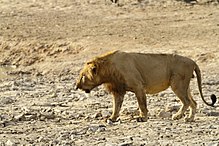Senegal lion
| West African lion | |
|---|---|
 |
|
| Male lion in Pendjari National Park, Benin. | |
 |
|
| Lioness from Mefou National Park, Cameroon. | |
| Scientific classification | |
| Kingdom: | Animalia |
| Phylum: | Chordata |
| Clade: | Synapsida |
| Class: | Mammalia |
| Order: | Carnivora |
| Suborder: | Feliformia |
| Family: | Felidae |
| Genus: | Panthera |
| Species: | P. leo |
| Subspecies: | P. l. leo |
| Trinomial name | |
|
Panthera leo leo (Linnaeus, 1758) |
|
 |
|
| Lions now roam in just 1.1% of their historic range in West Africa. | |
The West African lion (Panthera leo leo) is a lion population in West Africa that is listed as Critically Endangered on the IUCN Red List. This population is isolated and comprises less than 250 mature individuals. Already in 2004, the lion population in West and Central Africa was fragmented and estimated as comprising at most 1,800 individuals.
It was formerly considered a lion subspecies under the name P. leo senegalensis. In 2017, the lion populations in North, West Africa and Central Africa and Asia were subsumed under P. l. leo.
In 1826, Johann Nepomuk Meyer described a lion from Senegal under the scientific name name Felis leo senegalensis. In 1843, John Edward Gray described a specimen from Gambia in the British Museum of Natural History as Leo gambianus. In 1900, Paul Matschie described a specimen from Cameroon as Felis leo kamptzi. Later they were considered synonymous with Panthera leo senegalensis.
In a comprehensive study about the evolution of lions, 357 samples of 11 lion populations were examined, including some hybrid lions. The hybrids had descended from lions captured in Angola and Zimbabwe, and apparently Western or Central African lions. Results indicated that four lions from Morocco did not exhibit any unique genetic characteristics and shared mitochondrial haplotypes H5 and H6 with lions from West Africa, and together with them were part of a major mtDNA grouping (lineage III) that also included Asiatic samples. According to the authors, this scenario was in line with their theories on lion evolution. They conclude that lineage III developed in Eastern Africa, and then traveled north and west in the first wave of lion expansions out of the region some 118,000 years ago. It apparently broke up into haplotypes H5 and H6 within Africa, and then into H7 and H8 in Western Asia.
...
Wikipedia

